Thank you for visiting! By the way… any links on this page that lead to products on Amazon and other stores/partners are affiliate links Aquarium Store Depot earns a commission if you make a purchase.
Red Tailed sharks are lovely looking fish with a hidden dark side. This aggression makes it difficult to keep many community fish in the same tank with them. Choosing compatible Red Tail Shark tank mates can make a world of difference in cultivating an immersive underwater paradise that allows every species to prosper – and today we will help you find the best red tail shark tanks mates for your aquarium setup!
Key Takeaways
- Red Tail Sharks can live peacefully with other fish species if given the right care and understanding.
- Provide them with their own spot in a larger tank, ensure ideal water parameters & provide hiding spots for a harmonious aquarium.
- Choose larger, non-aggressive tank mates like Severums, Pearl Gouramis
- Schooling fish can work if fast, larger, and in large numbers like Tiger Barbs
Understanding Them
Red Tail Sharks can have a difficult relationship with their tankmates if they are not managed properly. When given appropriate care and understood within the context of their behavior, these jet black fish may thrive in harmony alongside other species of fish.
These fish are territorial by nature and get large and athletic. A target of theirs is usually not able to escape as they are relentless.
Behavior And Temperament
Red tailed black sharks, referred to as red tail or tailshark by many aquarists, are usually quite aggressive towards other aquarium fish, especially those species with a similar appearance or that like to stick close to the bottom (such as the rainbow shark). To provide them with an area in which they can feel comfortable and reduce stress levels. Fish that school will also be targets unless the numbers are so great that the shark is overwhelmed by the sheer numbers.

These fish are often confused with rainbow sharks, which are less aggressive. They are often mislabeled at fish stores.
Ideal Tank Environment And Parameters
A minimum of 55 gallons should be provided for a single shark. However, a 100 gallon tank or larger will have the best chances of success. At a minimum, the tank should be at least 4 feet in length, with 6 being recommended.
The problem I see with many Red Tail horror stories is that the fish is placed in a tank that is too small. These fish look cute and unique at the fish store and are often sold as juveniles. These juvenile red tail sharks are mild mannered when small, but they will come into their own when they reach around 3-4 inches in length. It is usually at this time when I see people post or message me about their problems. Often, these fish are placed in small tanks, usually 29 gallons. This is too small for them, and their territorial nature is too much for any inhabitant in the tank.
Regarding temperature ranges, keep them between 72-82°F and pH levels of 6.5 – 7.5. As long as your setup is on point, you should have good success with the fish we are going to discuss below.
Top 15 Red Tail Shark Tank Mates
Here we have 15 of the best tank mates suitable for Red Tail Sharks. Some are slam dunks, while others need caution exercised in order to keep them together successfully. With each pick, I’ll explain why they made it on the list and what to look out for. Let’s get go ahead and get started with this list!
1. Severums

- Scientific Name: Heros severus
- Adult Size: 8 inches
- Water Temperature: 75°F to 84°F
- Minimum tank size: 55 gallons
- Care Level: Moderate
- Diet – Omnivore
- Origin – South America
- Swimming Level – Bottom to mid
Severums, native to South America, are beloved for their eye-catching hues and placid demeanor. These gentle giants make an excellent companion species when placed in the same tank. These two varieties of fish will usually exist harmoniously without causing any trouble. Both will benefit from this shared environment as they display their majestic beauty with no conflicts between them. In most tank setups, your Severum will become the dominant member of the tank while enforcing the peace. It’s one of the best fish to use in a semi-aggressive tank.
2. Geophages
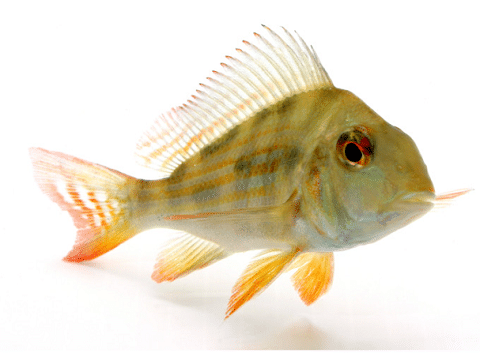
- Scientific Name: Geophagus spp.
- Adult Size: 5-8 inches
- Water Temperature: 76°F to 83°F
- Minimum tank size: 55-75+ gallons
- Care Level: Moderate
- Diet – Omnivore
- Origin – South America
- Swimming Level – Middle to Bottom
Geophages, are substrate stirring cichlids that can peacefully cohabit with Red Tail Sharks if they have enough room and the tank is properly set up. To avoid conflicts between both species, it’s necessary for an aquarium to contain plenty of material for the Geophage to filter through, along with a high functioning filtration system in order to maintain optimal water quality conditions.
The Geophages should also be larger when purchased. You can also keep them in groups to help add to the intimation factor.
3. Pearl Gourami

- Scientific Name: Trichopodus leerii
- Adult Size: 4-5 inches
- Water Temperature: 75°F to 82°F
- Minimum tank size: 30 gallons
- Care Level: Intermediate
- Diet – Omnivore
- Origin – Southeast Asia
- Swimming Level – Mid to top
Pearl Gourami, with their attractive visuals and peaceful temperament, make great tank mates for Red Tail Sharks. In an aquarium setting, they can coexist peacefully in the same aquarium due to occupying different areas within it. This provides an interesting yet balanced atmosphere that is perfect for any community tank that includes these two species of fish. These peaceful fish do best in a group, so plan on purchasing multiple.
4. Tiger Barbs
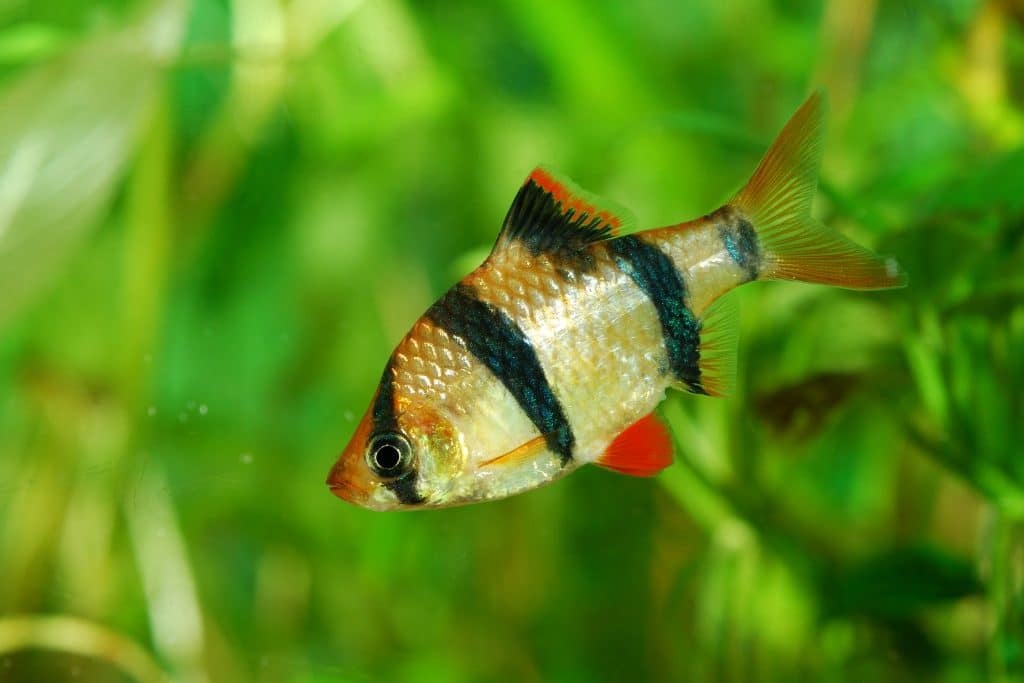
- Scientific Name: Puntius tetrazona, Barbus tetrazona, Capoeta sumatraus, Barbodes tetrazona, and Capoeta tetrazona
- Adult Size: 4-5 inches
- Water Temperature: 73°F to 86°F
- Minimum tank size: 20 gallons
- Care Level: Easy
- Diet – Omnivore
- Origin – Southeast Asia
- Swimming Level – Mid
Tiger Barbs are sometimes a disaster in a community tank setup. However, they are a good pick for a tank with a red tail shark in it. They have energetic behavior and an eye-catching appearance while also being able to balance out the temperament of Red Tail Sharks. These fast swimmers are hardy and easy to care for – making them one of the top choices when it comes to stocking up your dream aquatic home!
One thing to note is these fish can be bullied to death if you keep them in low numbers against the shark. You should plan on at least a school of 12 to have the best result.
5. Peacock Cichlids

- Scientific Name: Aulonocara
- Adult Size: 4+ inches
- Water Temperature: 74°F to 82°F
- Minimum tank size: 55 gallons
- Care Level: Moderate
- Diet – Omnivore
- Origin – East Africa
- Swimming Level – Mid to bottom
The attractive Peacock Cichlids can take the aggression of the red tail shark and also dish it out if needed. As they are of similar size, these fish will stalemate and will settle on their territorial if they do battle.
As they are not relentless with their aggression, having Peacock Cichlids as companions to the Red Tails will help maintain balance within your tank while adding beauty too! Stick with peacocks that are medium sized.
6. Hap Cichlids

- Scientific Name: Sciaenochromis spp.
- Adult Size: 6+ inches
- Water Temperature: 76°F to 82°F
- Minimum tank size: 75 gallons
- Care Level: Moderate
- Diet – Omnivore
- Origin – East Africa
- Swimming Level – Mid to bottom
Red Tail Sharks make suitable tank mates for Hap Cichlids because of their vibrant colors and semi-aggressive temperament. Adding these to a community aquarium is sure to be an aesthetically pleasing sight as they will not show any aggressive tendencies towards each other in the right environment. The two species can coexist peacefully, creating a wonderful underwater world that is sure to captivate viewers!
One thing to note is I omitted Mbunas. While some Mbunas are successful, like Electric Yellows, many Mbunas are too aggressive to the point where they could bully the shark to death.
7. Tinfoil Barb
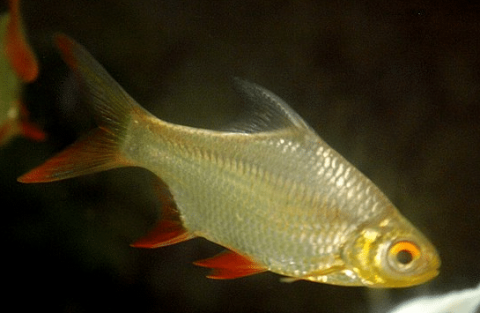
- Scientific Name: Barbonymus schwanenfeldii
- Adult Size: 14 inches
- Water Temperature: 72°F to 77°F
- Minimum tank size: 75 gallons
- Care Level: Moderate
- Diet – Omnivore
- Origin – East Asia
- Swimming Level – All
Tinfoil barbs are an ideal addition to a community tank. Characterized by their peaceful nature, they can peacefully coexist with Red Tail Sharks in the same aquarium if enough space is provided for them both. Being large, placid fish that need lots of swimming room makes them great partners for an active species like Red Tail sharks.
Their one-of-a-kind look adds aesthetic appeal and completes the harmonious environment created when having multiple different types of fish housed together. Be aware they require massive tanks and a group. 200+ gallons is recommended to house a school.
8. Silver Dollars
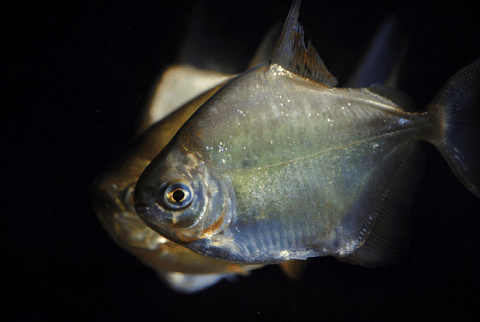
- Scientific Name: Metynnis argenteus / Metynnis hypsauchen
- Adult Size: 6 inches
- Water Temperature: 75°F to 82°F
- Minimum tank size: 75 gallons
- Care Level: Easy
- Diet – Omnivore
- Origin – South America
- Swimming Level – All
Silver Dollars make a great tankmate for Red Tail Sharks due to their peaceful nature and need for lots of room in the aquarium. This piranha lookalike with an impressive shimmering silver hue brings balance to the environment with its calm demeanor around large fish.
They are considered a large dither fish and are so fast and athletic that your red tail shark will not be about to bully them. Their silver colors also complement the Red Tail Shark perfectly. It’s one of the best and safest combos on the list.
However, note that Silver dollars will eat just about any aquatic plant you place in the tank.
9. Rainbowfish
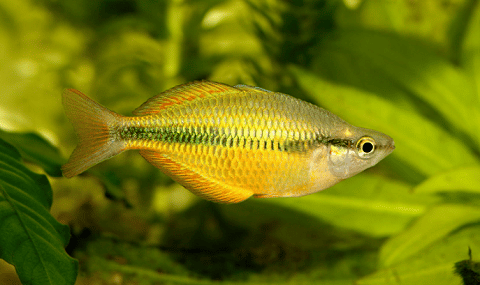
- Scientific Name: Melanotaenia boesemani
- Adult Size: 4-5 inches
- Water Temperature: 72°F to 77°F
- Minimum tank size: 40 gallons
- Care Level: Intermediate
- Diet – Omnivore
- Origin – Indonesia
- Swimming Level – Middle
Rainbowfish bring beauty and life to a community tank with their dazzling colors and energetic activity. As ideal tankmates for Red Tail Sharks, they show an affinity toward different areas of the aquarium, contrasting nicely against a Red Tailed Shark while also living in harmony there. These fish can be great additions to any aquatic space by providing color as well as the friendly interplay between species. Plan on keeping them in a large school and consider the larger species of rainbowfish.
10. Yoyo Loach
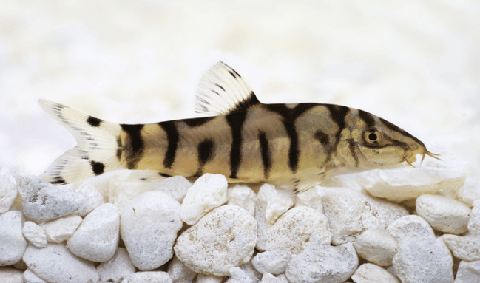
- Scientific Name: Botia Almorhae or Botia Lohachata
- Adult Size: 2.5 inches
- Water Temperature: 72°F to 77°F
- Minimum tank size: 30 gallons
- Care Level: Intermediate
- Diet – Omnivore
- Origin – India
- Swimming Level – Bottom
Yoyo Loaches, which are a type of bottom-dwelling fish, can peacefully coexist with Red Tail Sharks in the same community tank in most cases. To make sure they’re comfortable and have plenty of hiding spots to swim to when needed, proper tank setup is important. With that set up completed, these active social creatures will create an exciting, diverse environment below the water’s surface together with their red tail counterparts.
While it is possible your red tail shark will bully your yoyo loach, they are very active fish and can avoid them if there is enough space. If you have a very large tank, you could consider a school of clown loaches.
11. Bristle Nose Pleco

- Scientific Name: Ancistrus Cirrhosus
- Adult Size: 4 – 5 inches
- Water Temperature: 73°F to 80°F
- Minimum tank size: 30 gallons
- Care Level: Easy
- Diet – Herbivore
- Origin – Amazon
- Swimming Level – Bottom
The Bristle Nose Pleco is a peaceful algae eater that can coexist in the same tank with Red Tail Sharks. Their gentle personality and capacity to clean aquariums make them suitable for any community containing red tail inhabitants, plus they benefit from brine shrimp-based diets as well! Not only that, but their one of a kind look adds charm to an aquascape already inhabited by the sharks.
It is still possible for your red tail black shark could exhibit aggression, but chances are pretty good they can live together in large tanks.
12. Odessa Barb
- Scientific Name: Pethia padamya
- Adult Size: 3 inches
- Water Temperature: 70°F to 80°F
- Minimum tank size: 30 gallons
- Care Level: Easy
- Diet – Herbivore
- Origin – Southeast Asia
- Swimming Level – Mid
Odessa Barbs are active and lively, ideal for enhancing the beauty of a community tank. They can easily coexist with a Red Tailed Black Shark as they do not get intimidated by them. Odessa Barbs (video source) work well in school-type environments due to their social nature, making it a great addition to any aquarium setup containing red tail sharks! These resilient freshwater fish also make an excellent choice for beginners since they’re easy enough to care for.
13. Roseline Shark
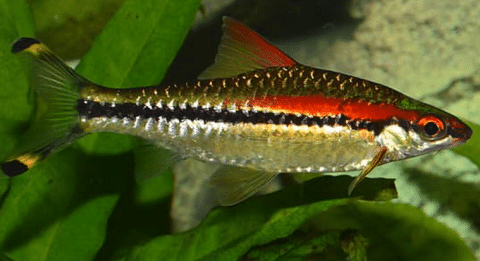
- Scientific Name: Sahyadria denisonii
- Adult Size: 6 inches
- Water Temperature: 65°F to 77°F
- Minimum tank size: 55 gallons
- Care Level: Moderate
- Diet – Omnivore
- Origin – India
- Swimming Level – Mid
Roseline Sharks have vibrant colors and are a great fit for tanks that contain Red Tail Sharks. They share the tank peacefully, allowing them to form an impressive multi-species setup in ample living space. This makes Roselines perfect mates for their red tail counterparts since they too are swift swimmers yet peaceful creatures at heart.
A community of both these species should provide plenty of visual stimulation while still being harmonious with one another due to the nature of how well-suited Roseline sharks can be as tankmates. They should be kept in large groups so they can’t be singled out by the red tail shark.
These are considered one of the riskier choices as the Roselines could outcompete the red tail shark in large numbers or can be bullied in small numbers. It’s easier to deal with your shark being outcompeted. Just learn to feed the two species separately.
14. Congo Tetra
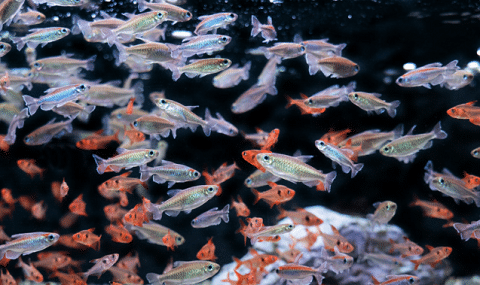
- Scientific Name: Phenacogrammus interruptus
- Adult Size: 2.5 – 3.5 inches
- Water Temperature: 73°F to 82°F
- Minimum tank size: 30 gallons
- Care Level: Moderate
- Diet – Omnivore
- Origin – Democratic Republic of Congo
- Swimming Level – Middle to Top
Congo Tetras are one of the larger tetra species available in the hobby, making them suitable tank mates for Red Tail Sharks. They rarely act aggressively and prefer to occupy different areas of the aquarium. Their light colors compliment the shark’s colors and their speed helps if the shark chases away any. Thus, they are perfect companions for those looking at setting up tanks featuring Red Tails alongside other species of fish (as long as they are kept in large numbers).
15. Blue Acara

- Scientific Name: Andinoacara pulcher
- Adult Size: 6 inches
- Water Temperature: 74°F to 82°F
- Minimum tank size: 40 gallons
- Care Level: Moderate
- Diet – Omnivore
- Origin – Hybrid
- Swimming Level – Middle to Bottom
Blue Acara, with their gorgeous colors and behavior, make ideal tank mates for Red Tail Sharks due to both species’ comparable size. Their peaceful temperament ensures harmony in a larger aquarium that is decorated well. These South American cichlids are able to peacefully coexist alongside the red tail creatures, creating an even more vibrant setting when included together in one community habitat.
Acaras can be bullied if you purchase one that is smaller than your red tail shark. To prevent this, make sure your Acara is sizably larger and that the freshwater shark is introduced after the Acara.
Bad Choices
In order to maintain a calm, peaceful community tank for Red Tail Sharks and their mates, you need to select the correct tankmates. Here are some bad choices not to consider so you don’t end up with bullied or stressed fish:
- Nano schooling fish
- Betta fish
- Danios – like Zebra Danios
- Livebearers – including Swordtails and Mollies
- Angelfish
- Freshwater shrimp
- Other freshwater shark species, such as the rainbow shark or bala sharks
- Housing more than one red tail shark in the same tank
With careful consideration, you can easily establish an attractive, thriving aquatic atmosphere that all your finned friends alike can enjoy!
Tips For Creating A Stress Fish Aquarium
An underwater environment with Red Tail Sharks without fighting is achievable through careful planning. Make sure the aquarium has sufficient space for each inhabitant to swim freely, as well as hiding spots like rocks or plants, in order to reduce aggression between fish species. It’s important that water parameters remain stable so all inhabitants stay healthy and safe.
Here are some other tips that should help you out:
- Add your red tail shark last or temporarily relocate the shark for a few weeks to reestablish territories
- Consider using a breeding box when introducing the fish to the community and observe interactions
- Make sure for similarity sized fish that the red tail is small at the time of purchase
- Consider a 6 foot long tank instead of a 4 foot long tank if you have the space for it
Frequently Asked Questions
Will a red tail shark eat other fish?
The potential of red tail sharks to be hostile towards other inhabitants in the tank must not go unnoticed, as their chasing and disruption of feeding may lead to deadly consequences for the latter. It is important that any aggressiveness exhibited by these particular fish is reigned in promptly.
Are red tail sharks aggressive to other fish?
Red Tail. Sharks can be quite aggressive with other fish, so it is important to ensure they have semi-aggressive tankmates and an abundance of places where they feel secure. Keeping the Red Tails happy should help reduce any potential hostility towards their fellow aquatic creatures.
Do red tail sharks clean the tank?
Red tail sharks are not as good at cleaning the tank and consuming algae compared to other species. To keep your aquarium in top condition, ensure you have sufficient amounts of growth-promoting light sources available for the algal population, then watch it flourish!
What fish can live with red tail catfish?
Harmonious cohabitation is possible between a Redtail Catfish and various species, including Oscars, Umbees, Stingrays, Pacu Fish Arowanas as well as Peacock Bass or Plecostomus.
What is the ideal tank size for Red Tail Sharks?
When it comes to housing your Red Tail Shark, the recommended minimum tank size is 55 gallons. A larger 100 gallon fish tank would be more suitable if you choose to keep multiple red tails together. This difference in scale should be taken into consideration before deciding on what kind of setup will work best for your shark’s home.
Can You Breed Red Tail Sharks?
Generally, breeding red tail sharks is not possible for the average aquarist. They are bred commercially with the help of hormones which is difficult to replicate.
Closing Thoughts
To experience the beauty and harmony of well-balanced community tanks, it is essential to understand the temperament of Red Tail Sharks and their tank mates. This includes providing an ideal environment that will ensure all fish species can coexist peacefully. With proper care, this special breed has the potential to be at the center of such surroundings!
Have you kept Red Tailed Sharks in the past? Let us know your experience in the comments below. Until next time fishkeepers!
- About the Author
- Latest Posts
I’m thrilled that you found Aquarium Store Depot! Here you’ll find information on fish, aquariums, and all things aquatics related. I’m a hobbyist (being doing this since I was 11) and here to help other hobbyists thrive with their aquariums! I adhere to a high quality Editorial Process and Review products with real life field usage and practical analysis.





